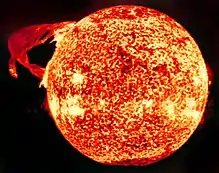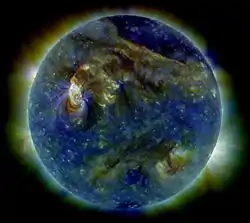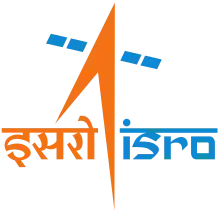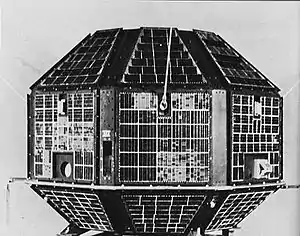Aditya-L1
Aditya (Sanskrit: आदित्य, lit: Sun,[5] ![]() pronunciation ) or Aditya-L1 is a spacecraft mission to study the Sun.[3] It has been designed[6] and will be built in collaboration between the Indian Space Research Organisation (ISRO)[3] and various Indian research institutes. It is planned to be launched in January 2022.[2] It is India's first solar mission.[7][8]
pronunciation ) or Aditya-L1 is a spacecraft mission to study the Sun.[3] It has been designed[6] and will be built in collaboration between the Indian Space Research Organisation (ISRO)[3] and various Indian research institutes. It is planned to be launched in January 2022.[2] It is India's first solar mission.[7][8]
 Aditya-L1 in deployed configuration (credit:ISRO) | |||||||||||||||||
| Mission type | Solar observation | ||||||||||||||||
|---|---|---|---|---|---|---|---|---|---|---|---|---|---|---|---|---|---|
| Operator | ISRO | ||||||||||||||||
| Mission duration | 5 years (planned) [1] | ||||||||||||||||
| Spacecraft properties | |||||||||||||||||
| Bus | I-1K | ||||||||||||||||
| Manufacturer | ISRO / IUCAA / IIA | ||||||||||||||||
| Launch mass | 1,500 kilograms (3,300 lb) [1] | ||||||||||||||||
| Payload mass | 244 kg (538 lb) (approx.) [1] | ||||||||||||||||
| Start of mission | |||||||||||||||||
| Launch date | January 2022[2] | ||||||||||||||||
| Rocket | PSLV-XL[1][3] | ||||||||||||||||
| Launch site | Satish Dhawan Space Centre | ||||||||||||||||
| Orbital parameters | |||||||||||||||||
| Reference system | Sun–Earth L1 | ||||||||||||||||
| Regime | Halo orbit | ||||||||||||||||
| Period | 177.86 days[4] | ||||||||||||||||
| |||||||||||||||||
History
Aditya was conceptualised in January 2008 by the Advisory Committee for Space Research. It was initially envisaged as a small 400 kg, low-Earth orbiting satellite with a coronagraph to study the solar corona. An experimental budget of 3 Crore INR was allocated for the financial year 2016–2017.[9][10][11] The scope of the mission has since been expanded and it is now planned to be a comprehensive solar and space environment observatory to be placed at the Lagrangian point L1,[12] so the mission was renamed "Aditya-L1". As of July 2019, the mission has an allocated cost of ₹378.53 crore excluding launch costs.[13]
Overview

The Aditya-L1 mission will be inserted in a halo orbit around the L1 point, which is about 1.5 million km from Earth. The 1,500 kg satellite carries seven science payloads with diverse objectives, including but not limited to, the coronal heating, solar wind acceleration, coronal magnetometry, origin and monitoring of near-UV solar radiation (which drives Earth's upper atmospheric dynamics and global climate), coupling of the solar photosphere to chromosphere and corona, in-situ characterisations of the space environment around Earth by measuring energetic particle fluxes and magnetic fields of the solar wind and solar magnetic storms that have adverse effects on space and ground-based technologies.[1]
Aditya-L1 will be able to provide observations of Sun's photosphere, chromosphere and corona. In addition, an instrument will study the solar energetic particles' flux reaching the L1 orbit, while a magnetometer payload will measure the variation in magnetic field strength at the halo orbit around L1. These payloads have to be placed outside the interference from the Earth's magnetic field and hence could not have been useful in the low Earth orbit as proposed on the original Aditya mission concept.[14]
One of the major unsolved issues in the field of solar physics is that the upper atmosphere of the Sun is 1,000,000 K (1,000,000 °C; 1,800,000 °F) hot whereas the lower atmosphere is just 6,000 K (5,730 °C; 10,340 °F). In addition, it is not understood how exactly the Sun's radiation affects the dynamics of the Earth's atmosphere on shorter as well as on longer time scale. The mission will obtain near simultaneous images of the different layers of the Sun's atmosphere, which reveal the ways in which the energy may be channeled and transferred from one layer to another. Thus the Aditya-L1 mission will enable a comprehensive understanding of the dynamical processes of the Sun and address some of the outstanding problems in solar physics and heliophysics.
Payloads
- Visible Emission Line Coronagraph (VELC): The coronagraph creates an artificial total solar eclipse in space by blocking the sunlight by an occultor. This telescope will have capabilities of spectral imaging of the corona in visible and infra-red wavelengths. The objectives are to study the diagnostic parameters of solar corona and dynamics and origin of coronal mass ejections (using three visible and one infra-red channels); magnetic field measurements of the solar corona down to tens of Gauss. Additional objectives are to determine why the solar atmosphere is so hot, and how the changes in the Sun can affect space weather and Earth's climate. The VELC payload weighs nearly 170 kg.[15]
- PI Institute: Indian Institute of Astrophysics (IIA)
- Solar Ultraviolet Imaging Telescope (SUIT): SUIT will observe the Sun between 200-400 nm wavelength range and it will provide full disk images of different layers of the solar atmosphere by making use of 11 filters. The Sun has never been observed from space in this wavelength range. The spacecraft being at the first Lagrangian point, SUIT shall be observing the Sun continuously without interruption. The instrument is being developed under the leadership of A. N. Ramaprakash and Durgesh Tripathi at the Inter-University Centre for Astronomy and Astrophysics (IUCAA) at Pune, in collaboration with ISRO and other institutes. The SUIT payload weighs nearly 35 kg.[15]
- PI Institute: Inter-University Centre for Astronomy and Astrophysics (IUCAA), Pune.
- Co-I Institutes: Indian Institute of Astrophysics (IIA), Center of Excellence in Space Sciences India (CESSI)-IISER Kolkata.
- Aditya Solar wind Particle Experiment (ASPEX)[16]: To study the variation and properties of the solar wind as well as its distribution and spectral characteristics.
- PI Institute: Physical Research Laboratory (PRL).
- Plasma Analyser Package for Aditya (PAPA): To understand the composition of solar wind and its energy distribution.
- PI Institute: Space Physics Laboratory (SPL), VSSC.
- Solar Low Energy X-ray Spectrometer (SoLEXS): To monitor the X-ray flares for studying the enigmatic coronal heating mechanism of the solar corona.
- PI Institute: ISRO Satellite centre (ISAC).
- High Energy L1 Orbiting X-ray Spectrometer (HEL1OS): To observe the dynamic events in the solar corona and provide an estimate of the energy used to accelerate the solar energetic particles during the eruptive events.
- PI Institutes: ISRO Satellite Centre (ISAC) and Udaipur Solar Observatory (USO), PRL.
- Magnetometer[17]: To measure the magnitude and nature of the interplanetary magnetic field.
- PI Institute: Laboratory for Electro-optic Systems (LEOS) and ISAC.
References
- Somasundaram, Seetha; Megala, S. (25 August 2017). "Aditya-L1 mission" (PDF). Current Science. 113 (4): 610. doi:10.18520/cs/v113/i04/610-612. Retrieved 25 August 2017.
- S. Somanath (3 August 2020). An Evening with Dr. S. Somanath, Director, VSSC, Trivandrum (video). Event occurs at 45:09–46:04. Retrieved 14 August 2020 – via YouTube. Presentation slides available here via Imgur.
- "ISRO planning to launch satellite to study the sun". The Hindu. 13 January 2008. Retrieved 10 November 2008.
- Sreekumar, P. (19 June 2019). "Indian Space Science & Exploration : Global Perspective" (PDF). UNOOSA. p. 8. Retrieved 30 June 2019.
- "Aditya". Spoken Sanskrit. Archived from the original on 19 July 2011. Retrieved 14 November 2008.
- "After Chandrayaan-1's moon voyage, ISRO's Aditya to scout sun's surf". United News of India. 11 November 2008. Retrieved 14 November 2008.
- "Aditya L1: Know Everything about ISRO's First Solar Mission". www.jagranjosh.com. 30 December 2019. Retrieved 31 December 2019.
- "8 pictures you must see to understand what ISRO's Aditya L1 is looking for". Business Insider. Retrieved 31 December 2019.
- "Notes on Demands for Grants, 2016-2017" (PDF) (Press release). Department of Space. Archived from the original (PDF) on 17 September 2016. Retrieved 9 September 2016.
- "Aditya gets ready to gaze at the sun". The Hindu. Retrieved 25 August 2017.
- Gandhi, Divya (13 January 2008). "ISRO planning to launch satellite to study the sun". The Hindu. Retrieved 26 August 2017.
- Desikan, Shubashree (15 November 2015). "The sun shines on India's Aditya". The Hindu. Retrieved 12 August 2018.
- "Lok Sabha Unstarred Question No.1972" (PDF). LokSabha. 3 July 2019.
- "Aditya - L1 First Indian mission to study the Sun - ISRO". www.isro.gov.in. Retrieved 19 June 2019.
- Desikan, Shubashree (26 November 2017). "Here comes the sun watcher, India's Aditya-L1". TheHindu. Retrieved 26 November 2017.
- Goyal, S. K. (18 April 2018). "Aditya Solarwind Particle EXperiment (ASPEX) onboard the Aditya-L1 mission". Planetary and Space Science. 163: 42–55. doi:10.1016/j.pss.2018.04.008. Retrieved 18 May 2020.
- Yadav, Vipin K. (8 November 2017). "Science objectives of the magnetic field experiment onboard Aditya-L1 spacecraft". Advances in Space Research. 61 (2): 749–758. doi:10.1016/j.asr.2017.11.008. Retrieved 18 May 2020.
External links
- "Aditya - L1 First Indian mission to study the Sun". Indian Space Research Organisation. Retrieved 1 June 2017.




